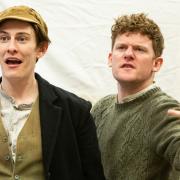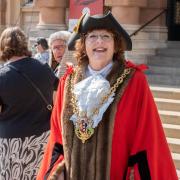John Wright reveals more about Sister Phyllis’ time with Field Marshall Bernard Montgomery

He would have been a little terror, six-year-old Bernard Montgomery, a real handful for his first teacher, a no-nonsense nun from Suffolk. Just how Sister Phyllis – or Jemima Stevens as she was known in her native Aldeburgh – followed a calling that took her across the globe and landed her the task of taming the boisterous boy who would go on to become one of the most controversial war leaders Britain has ever had, Field Marshall Bernard Law Montgomery, 1st Viscount Montgomery of Alamein, KG, GCB, DSO, PC, is quite a tale.
It begins in the middle of the 19th century. Bernard’s (Monty’s) parents, the Reverend Henry Hutchinson Montgomery and Maud Farrer, were an odd couple. Henry, an Anglo-Irish Anglican priest in London, was 32 when, in 1879, he proposed to the 14-year-old daughter of Frederic William Farrar, canon of Westminster and Henry’s old Harrow housemaster. Two years later they married.
In 1887, Henry inherited his family’s estate in County Donegal, Ireland, and promptly sold farms to pay the £13,000 still owing on the mortgage. It left little for the estate’s upkeep, or the poor couple’s summer holidays. So, Henry jumped at the church’s offer of a large income in a much bigger parish – the only catch being that it was on the other side of the world.
He would certainly have a grand title, the fourth Bishop of Tasmania, but what it really meant was spreading the word to the largely deaf ears of hardened settlers and aborigines living in an area of dense bushland and mountains half the size of England.

Henry couldn’t wait. In October 1889, he and Maud arrived in Hobart, southern Tasmania, with five young children including two-year-old Bernard (four more arriving later). Henry set about raising £10,000 (£1.3 million today) to expand St David’s Cathedral and tackle “Education, Temperance and Social problems between classes”. He loved missionary work, and the wilder the country the more the former sportsman liked it.
Read about the Suffolk vicar who started an Aussie gold rush

By the time Bernard came under the instruction Sister Phyllis, he had already felt the effects of Maud’s parenting. She was certainly strict. Monty’s memoirs refer to the “military” way his mother brought them up. Nigel Hamilton, in his book Monty: The Making of a General, quoted him as saying that she gave them “constant” beatings and ignored them while performing her public duties as a bishop’s wife. Her era regarded caning as normal punishment for misbehaving children, and bringing tutors from England suggests carefulness. If she was unkind, could mother and son have been cut from the same cloth?
Biographer Arthur Chalfont in Montgomery of Alamein seems to jump to conclusions about Montgomery family life, saying “the loveless environment made Bernard something of a bully, as he himself later recalled, ‘I was a dreadful little boy. I don’t suppose anybody would put up with my sort of behaviour these days’”. Some had no choice. Like Sister Phyllis, who arrived in Hobart from England on the ship RMS Coptic on September 14, 1892, with six other nuns, invited by Bishop Montgomery to set up a school.
Sister Phyllis was born Jemima Stevens, the daughter of William Stevens, “gentleman”, and his wife Maria (née Moss) on August 20, 1855, in the developing seaside resort town of Aldeburgh where her childhood was spent running on the shingle and playing among the fishing boats.
Aldeburgh Museum has mention of a Mrs Maria Stevens in a lodging house at Sweaborg Cottage, Crabbe St, Aldeburgh in the 1869 Post Office directory, when Jemima was 14. A museum volunteer told me, it was unknown if Maria was living in the lodging house or whether she kept it and provided lodgings for other people, but the museum’s photograph shows the terrace containing Sweaborg Cottage (c1890) a year before Jemima left East Anglia.

Jemima looked after her widowed mother, and was 33 when she joined the Community of the Sisters of the Church in East London. Here she worked helping the poor, in squalid conditions, for four years before boarding ship with her fellow sisters for Tasmania.
The Hobart school was founded on October 3, 1892, with an initial enrolment of six girls and six boys – one being the mischievous Bernard. Sister Phyllis and Sister Hannah, and an orphan girl, remained in Hobart while the other nuns moved to mainland Australia to start a school there.
In July 1893 Sister Phyllis ran the mission school for poor children, then in October returned to the elementary school to teach the boys. She was soon in hot water, accused by some of spreading “false doctrines in their religious classes” by making the kids go to confession. But the Bishop of Tasmania’s inquiry exonerated her. Philip Hart in The Companion to Tasmanian History wrote that “his family fell ‘under the spell of the charm and simplicity of colonial life’, and was ‘ideally happy’”, adding that Monty “recalled him as a henpecked saint”.
The school gradually expanded. By July 1895 it had 71 students and moved to a grand house in Macquarie Street, Hobart and became known as The Collegiate School. After 1898, when Bernard was 11, boys were no longer accepted at the school. Meanwhile, his father should probably not have told the Archbishop of Canterbury in 1901 how much he was enjoying his parish work. Within months of writing, “A man must be a leader in the Colonies. The quiet, harmless man will fail. It is all push. . . all pioneer work, even in the cities”, Henry found himself back in London. Perhaps, ironically, it was his passion that church leaders needed back in the capital.
The family left Tasmania in January 1902 which freed Bernard, at 14, to bother someone else. He went to St Paul’s School in London and then the Royal Military Academy, Sandhurst, where he was almost expelled for setting fire to a fellow cadet during a fight with pokers. The incident says it all.
Equally passionate was Sister Phyllis, who won the respect of students, parents and the community and proved that she was there for the long haul. She ran the school until 1927. It’s still going strong and, today, is one of the best known private girls’ schools in Tasmania, St Michael’s Collegiate School.
Alison Alexander described Sister Phyllis in the Australian Dictionary of Biography as “dignified and gracious, as well as forceful and competent”. By the time she died at the school on March 5, 1940, at the age of 84, Sister Phyllis would have heard how the grittier side of her little Monty’s character was preparing him to do what British families would never forget him doing – helping Britain to battle her way to victory in the Second World War.
What was Monty really like?
Sister Phyllis certainly had her work cut out when it came to her young pupil. But the part Monty played in Britain and its allies finally emerging victorious from the Second World War will be revered by history, regardless of what he was really like as a person.
Some years ago, I asked someone who fought under him in North Africa, my aunt’s brother-in-law, Geoff Temple-Smith, what it was like. Geoff was a 21-year-old captain in Monty’s 8th Army in 1943 when he ran up a strategic hill in Sicily with his platoon after shouting, “Follow me, men!” – into fire from 29 German machine-guns. They took the hill, despite Geoff being shot repeatedly in the leg, and he was awarded a Military Cross for bravery.
“He was a man to die for,” Geoff, son of a pacifist and a daffodil-breeder, told me in 2009 from his home in Tasmania. “Monty sent round this piece of paper with orders of the day, rather like Henry V at Agincourt. He was very self-confident. . . egotistical. . . but he was the right person for the job, whereas some were a bit fuzzy. Everyone who fought under him liked him because he was a winner.
“I don’t think I’d be very keen on him as a man. He was bombastic and all the things you don’t like in peacetime. He’s alleged to have taken credit for work [the Egyptian town of] Alexandria did for repelling the Germans before he took over,” Geoff said, adding that Monty’s squabbling with Americans compromised his men’s safety, his success at El Alamein being partly due to his “overwhelming superiority”. Some said Monty never admitted mistakes, others that he didn’t like obeying orders. US general Walter Smith once said: “You may be great to serve under. . . but you sure are hell to serve over!” Churchill’s foremost military advisor, Field Marshall Alan ‘Brookie’ Brooke, called him “a difficult mixture to handle”.



























